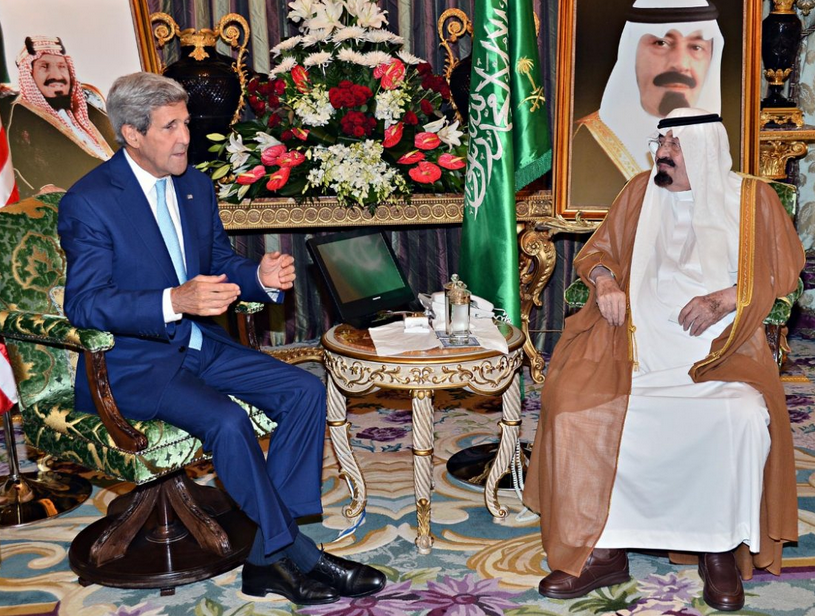For the U.S.-Saudi diplomatic relationship, what a difference 9 months makes.
Less than a year ago, a flood of analysts and commentators were debating whether the U.S.-Saudi alliance would survive what some were calling the lowest point in that relationship in decades.
But just 9 months later, with Secretary Kerry in Jeddah for talks on direct military and strategic cooperation with Saudi Arabia and other GCC states to defeat a new threat, the U.S.-Saudi “special relationship” appears significantly stronger.
The ‘Break Up’ That Wasn’t
Speculation that the U.S.-Saudi Arabia relationship was in trouble picked up momentum when Saudi Arabia renounced its two-year rotating seat at the UN Security Council. The surprising move by the Kingdom was a protest against what it saw as UN ineffectiveness, particularly over Syria and Palestine.
Shortly thereafter, the U.S.-Saudi relationship got worse with a report detailing a meeting held by a former Saudi ambassador to the United States Prince Bandar bin Sultan in France in the autumn of 2013. Then in his role as chief of intelligence with the Syria portfolio, Prince Bandar told ambassadors at a meeting that the Saudis would no longer proceed in Syria in lock step with the United States, Ellen Knickmeyer of the Wall Street Journal reported. The Saudi government disagreed with Obama’s handling of Syria after Obama set a “red line” but then declined to strike Syria without congressional approval.
Building on that sentiment, on December 17th, 2013, Saudi Arabia’s ambassador to the U.K. Prince Mohammed bin Nawaf’s op-ed in the New York Times blasted what the Kingdom saw as indecisiveness and Western inability to restore stability in the Middle East. “We believe that many of the West’s policies on both Iran and Syria risk the stability and security of the Middle East. This is a dangerous gamble, about which we cannot remain silent, and will not stand idly by.”
“We expected to be standing shoulder to shoulder with our friends and partners who have previously talked so much about the importance of moral values in foreign policy. But this year, for all their talk of “red lines,” when it counted, our partners have seemed all too ready to concede our safety and risk our region’s stability.”
Syria wasn’t the only issue threatening to drive a wedge between the two allies. A perceived thaw in U.S.-Iran relations, American criticism of the political situation in Egypt, and a U.S. domestic energy boom created the impression that core areas of political and economic cooperation were weakening.
Although many foresaw a “breakup,” others disagreed. Writing in March, 2014, CSIS’ Anthony Cordesman said, “The United States does not need to rebuild its alliance with Saudi Arabia as much as build a new form of alliance based on the new realities of the Middle East. Both sides need to recognize these changing realities, and the uncertainties involved, and develop a new level of cooperation. At the same time, they need to be more tolerant of the other side’s positions.”
Diplomacy in Action
The Obama administration was extremely responsive to Saudi Arabia’s vocal dissatisfaction with the state of the U.S.-Saudi relationship with increased contact from key government officials including a visit from the President himself in March – the second visit that Obama made to Saudi Arabia.
Subsequent visits by high level American officials, including several by Secretary of State John Kerry and Secretary of Defense Chuck Hagel, Commerce Secretary Penny Pritzker, and others reflected the Obama’s administration’s commitment to strengthening a relationship that has been “tested” by regional crisis.
As a result, the perceived gap between the United States and Saudi Arabia steadily – and quietly – appeared to diminish n several regional issues and areas of mutual concern. With the rise of the Islamic State and a new Prime Minister in Iraq, the United States and the Kingdom’s interests become more aligned than they have for some time.
Historical Cooperation?
While there is cause for optimism that a an increasingly cooperative US-Saudi relationship is on the horizon, we can only wait and see as to how the rise of the Islamic State improves the situation beyond surface-level promises. As expert Fahad Nazer wrote yesterday in NOW, “A perceived lack of a clear US strategy will make the Saudis think twice about committing to the US effort, putting the entire endeavor in jeopardy.”
Still, the emergence of the IS threat is a unique opportunity for the President to reset his image in the region. As David Ignatius of the Washington Post wrote today, “Obama’s decision to combat the Islamic State offers him a chance to reset U.S. leadership and his own presidency after growing doubt at home and abroad about what, if anything, he was willing to fight for. His innate cautiousness is now actually a reassurance that he’ll fight this war sensibly, partnering with allies in the region, in a way that doesn’t needlessly exacerbate the United States’ problems with the Muslim world.”
Details on the Obama administration’s effort at courting Saudi Arabia and the GCC states to form a full partnership in fighting the Islamic State are rapidly evolving, but what is clear by now is that Saudi Arabia is receptive to a more active American strategic response. Before speaking to the country on Thursday, President Obama called Saudi Arabia’s King Abdullah and both discussed their willingness to work together to combat the Islamic State.









